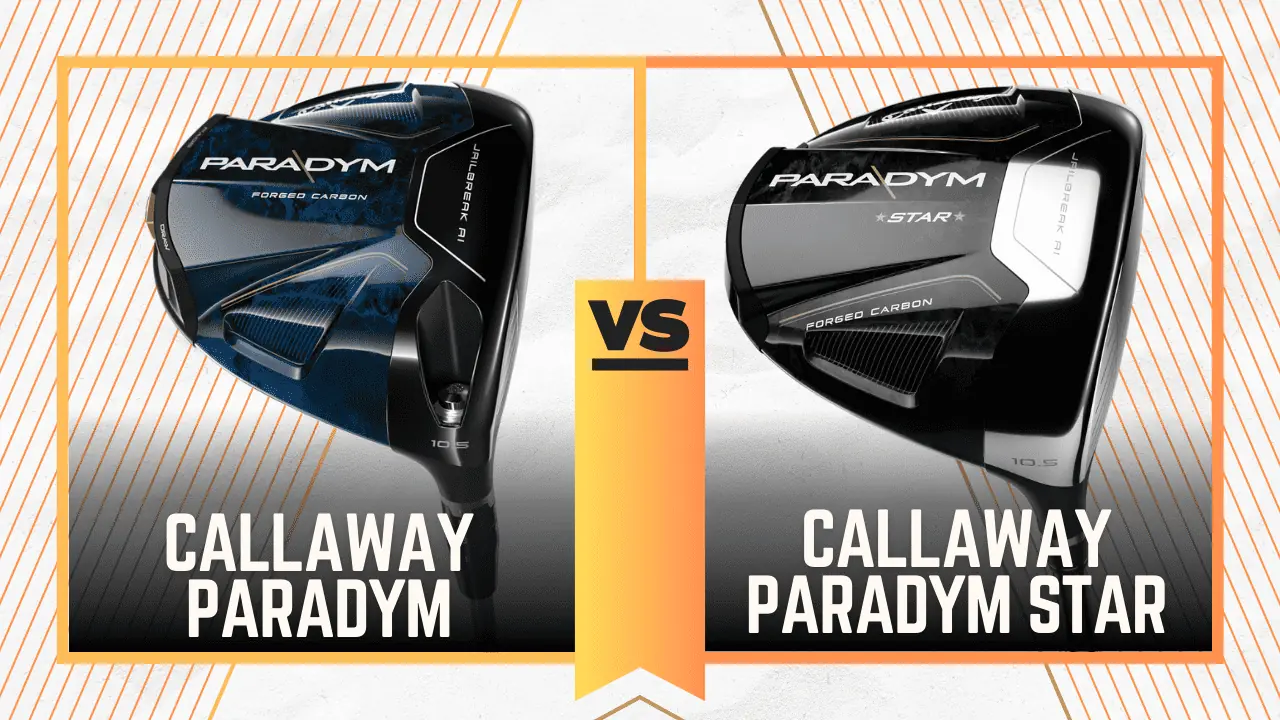Table of Contents
In this post, I conduct a Callaway Paradym vs Paradym Star 2023 review to see which is best for your golf game.
My moderate swing speed enjoys the neutrality of the launch, flight, and spin delivered by the Paradym. However, I also appreciate the increased swing speed from the lightweight Callaway Paradym Star components.
By the end of this article, you will know the critical differences between the Paradym and Paradym star drivers, fairway woods, hybrids, and irons. I will also explain which Callaway Paradym clubs work best for fast and slow swing speeds.
🏌️♂️ Read Next: Best Callaway Golf Irons of 2023

What are the Differences Between Callaway Paradym vs Paradym Star 2023
You will notice that the Paradym and Paradym Star carry the same game improvement technology from Callaway. The differences become apparent in the loft, launch, spin, ball flight, and level of forgiveness. Keep reading to learn what makes the drivers, fairway woods, hybrids, and irons different in each set.
Callaway Paradym Driver vs Callaway Paradym Star Driver Review
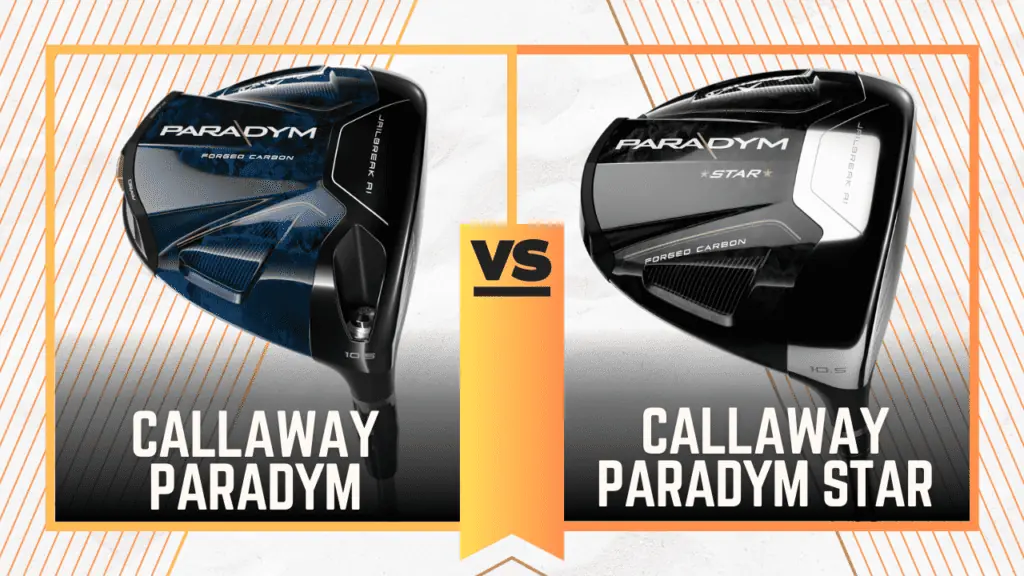
Both the standard Callaway Paradym and Paradym Star Drivers sport A.I. Jailbreak Technology and a Forged Titanium Cup Face. These components expand the active zone for enhanced rebound off the clubface, resulting in low spin and explosive ball speed for farther distance off the tee.
Callaway engineers also fitted a Carbon Chassis to the driver to lighten the load and optimize weight distribution. This increases the moment of inertia (MOI), helping the clubface resist twisting on the downswing, working to square up at contact.
The equally distributed mass pushes the CG low and deep in the clubhead to encourage a medium to high launch profile. Keep reading to find out where the difference lies between the Paradym vs Paradym Star driver.
Launch
Although the Paradym and Star both launch high, I found the latter developed a marginally superior apex off the tee. The lightweight components, low CG, and flexible shaft on the Star maximized my energy transfer into contact, prompting an effortless launch.
Moderate-swing speed golfers will have no issue launching the Paradym and should appreciate the neutral flight. However, slow swing speeds will welcome added clubhead speed and energy transfer into contact to accelerate ball zip and minimize spin.
🏌️♂️ Read More: Callaway Rogue vs Mavrik Drivers
Flight Bias
The Callaway Paradym and Paradym Star produce marginally different flight shapes. In my experience, the Paradym delivers a neutral bias, while the Star is set up for draw bias flight. The draw bias design is built to simplify squaring the clubface at contact for reduced slice side spin.
I find mid and low handicappers are better off with a neutral flight driver in the hand while high handicappers suit a draw bias design. I would suggest that beginners or high handicappers struggling with accuracy off the tee look at the Paradym Star.
Loft Options
Callaway only crafts the Paradym Star driver in a 10.5 and 12° loft profile, making them more suitable for players seeking an elevated launch. The Paradym is also available in a 10.5 and 12° loft. However, the engineers added a 9° option to suit faster swing speeds that demand a lower launch.
I would advise high handicappers and slower swing speed seniors to stick to the 10.5 and 12° profile of each range. I also noticed that the lie angle on the Paradym Star drivers is 2.5° higher than the Paradym, encouraging an easy launching tee shot.
Weight
The Callaway Paradym Star consists of lightweight golf club components designed to accelerate clubhead speed on the downswing. I lost an element of clubface control on the downswing with the Star owing to the increased torque and flex of the shaft. It caused me to leave my clubface open to the path at contact, causing a slice.
However, the lighter structure of the Callaway Star driver is a blessing for slower swing speeds struggling to maximize power into contact.
Stock Shafts
I find the Callaway Paradym Star drivers lack alternative shaft options should you desire a different launch or spin profile. The only option is the UST Mamiya Attas Speed Series 40, which features a low kick point and medium spin profile, leading to an elevated launch.
Conversely, the Callaway Paradym drivers boast 5 stock shafts to choose from for the ideal launch, spin, and distance results. The Aldila Ascent PL Blue 40 Graphite is the top pick for slow and moderate swing speeds after a higher launching tee shot. However, the remaining alternatives produce a low or medium launch.
The Project X HZRDUS Gen 4 Black 60 Graphite and Fujikura Ventus TR Blue 6 Graphite deliver the lowest launch from past experience.
Callaway Paradym vs Paradym Star Fairway Woods Review
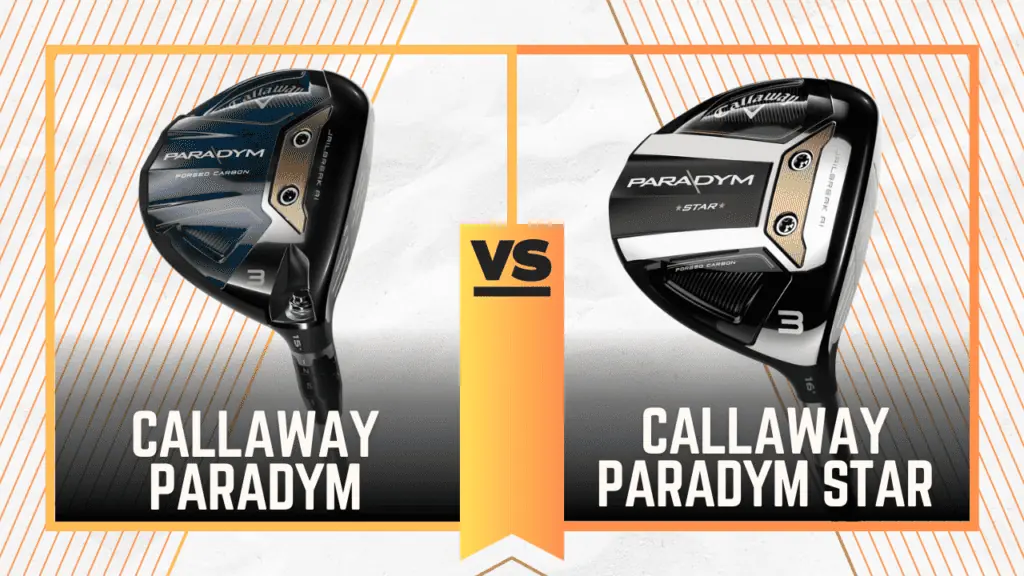
Like the drivers, the Paradym and Paradym Star fairway woods share the same technology. Their differences are spotted in the adjustability of the hosel, the loft, and flight bias. The core features include the C300 maraging steel face and a tungsten speed cartridge.
I found that the C300 maraging face delivered consistently fast ball speed, leading to optimal carry and total distance. Callaway engineers fitted a 23-gram Tungsten Speed Cartridge into both the Paradym and Paradym Star to lower the CG, enhance the stability, and send the ball high and long.
Lofts
The lofts on the 3, 5, 7, and 9-woods in the Paradym Star range are 1° weaker than the corresponding Paradym club. For example, the Paradym Star 3 wood is set at 16° compared to the 15° Paradym Fairway Wood. The extra degree of loft encourages a marginally higher launch, helping mid and high-handicappers get the ball off the deck.
Flight Bias
I noticed that the Callaway Golf Paradym Star carries more offset compared to the standard Paradym, encouraging a draw-bias flight. The draw bias profile works wonders for high handicappers seeking to combat slices.
Conversely, the neutral flight bias on the Callaway Golf Paradym proved easier to induce a controlled draw or fade.
⛳️ Read More: Callaway Supersoft vs Supersoft Max Golf Balls
Forgiveness
I have no issues with the forgiveness of the Callaway Paradym as a mid-handicapper. However, I find the Paradym Star is more lenient overall, owing to its slice-fighting draw bias and lightweight components.
The Paradym Star is easier to unload at the top of the swing and accelerate into impact, maximizing energy transfer. In addition, the Speed Cartridge helped me stabilize the clubface at contact, prevent spin drop-off off, and preserve ball speed.
Adjustable Hosel
If you appreciate the freedom of adjusting the loft and lie of your fairway woods, then the Paradym 3 wood and 3 HL wood are the way to go. The adjustable hosel enables you to increase or decrease the loft to achieve your desired launch.
The Callaway engineers bonded the hosel on the Callaway Star, eliminating the ability to adjust your loft and lie.
Weight
The Paradym Star offers lightweight fairway woods compared to the Callaway Paradym. These are specifically designed to help slow swing speeds accelerate on the downswing. Although I appreciated the faster clubhead speed into impact, I found the lighter shaft components challenging to control, often popping the clubface open.
My moderate clubhead speed struck the ball better with the standard-weight Paradym fairway woods.
Stock Shafts
The Paradym Fairway Woods offers a broader selection of stock shafts to meet your spin, launch, and flex requirements. All Paradym shafts are designed for medium spin and launch except for one. The Project X HZRDUS Gen 4 Black 70 graphite shaft suits players searching for a lower launch and minimal spin.
Paradym Star fairway woods are fitted with UST Mamiya Attas Speed Series 40 shafts designed for maximum flex and a high launch.
Callaway Paradym vs Callaway Paradym Star Hybrids
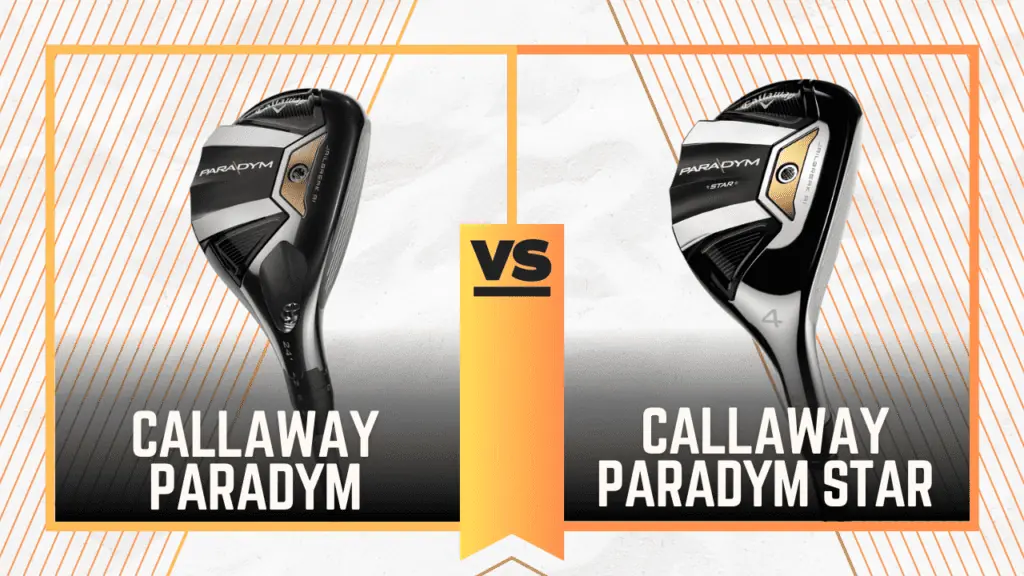
Paradym Star and Paradym hybrids contain A.I. Jailbreak and Batwing Technology, which increases MOI and lowers the CG. The combination minimizes the risk of twisting the clubface during your swing, encouraging straighter shots.
Callaway applied a Cutwave Sole Design to the hybrids to restrict turf interaction and promote a clean strike from any lie. Finally, both golf hybrids sport a high-strength 455 Face Cup, which expands the active zone, prompting rapid spin and low spin across a wider area of the clubface.
Now that you know the similarities of these clubs, keep reading to learn how they differ.
Lofts
The lowest lofted hybrid in the Paradym range is a 3-hybrid, built with 18° of loft. Conversely, the Paradym Star starts with a 4-hybrid with 21°. The lofts of both ranges are the same on the 4, 5, and 6-hybrid, with the latter set at 27°.
A 6-hybrid is the weakest lofted Paradym hybrid, but a 30° 7-hybrid is the highest loft you will find in the Paradym Star range.
Shafts
Callaway Paradym Star hybrids are fitted with the Ust Mamiya Attas Speed Series 50 shaft. I found it launched higher than any Paradym stock shafts, and slow swing speeds will have no trouble launching the Attas Speed Series.
Paradym hybrids offer two mid-launching, mid-spinning shafts, and a higher-launching model in the form of the Aldila Ascent Blue 50 HB/IR.
Weight
The most significant difference between the two hybrid ranges was the weight. Callaway suggests that the Paradym Star is 33 grams lighter than standard edition hybrids, and I believe it. While I prefer the additional weight in the Paradym hybrids for my swing, the Star is better equipped for a slow swing speed.
According to True Spec Golf, players swinging a 4 hybrid below 83 mph are judged to have slow clubhead speed.
Footprint
I thought the Paradym Star contained an oversized footprint, which explains its elevated MOI, wide sweet spot, and low CG. This works for high handicappers seeking maximum forgiveness but is off-putting to skilled players.
Callaway has mid to low handicappers covered with the Paradym hybrids. They carry a player’s footprint that is refined and a pleasure to gaze down upon at address.
Offset
If you are prone to slicing the odd shot, I suggest a moderate to high offset like the Paradym Star hybrid. I found the club easier to square up at contact, minimizing slice side spin to enjoy straighter flight.
I welcome the accuracy produced from the offset Paradym Star. However, I delivered inconsistent flight when executing a draw or fade. That is where I preferred the Paradym. Its neutral flight bias made it effortless to get my clubface into position to induce a draw or a fade.
Low to mid-handicappers may prefer the neutral setup of the Paradaym and the control it offers over your golf ball flight.
Adjustable Hosel or Fixed Hosel
Callaway decided to employ an adjustable hosel on the Paradym, enabling you to alter the loft and lie of the clubface. While skilled players may appreciate the ability to tinker with the settings, I suggest higher handicappers or beginner golfers keep it simple with the fixed hosel on the Paradym Star.
Forgiveness
As a mid handicapper, I found the Paradym offered sufficient forgiveness on my off-center strikes. However, I felt the Paradym Star was more efficient in reducing the impact of heel and toe mishits due to its higher offset profile.
Callaway Paradym vs Callaway Paradym Star Irons Review
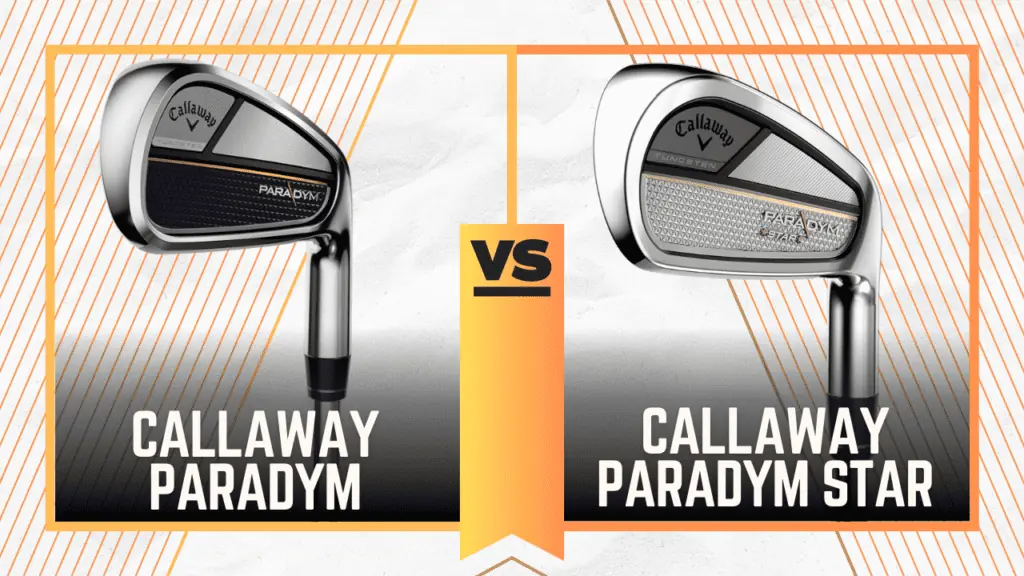
Callaway equipped the Paradym and Paradym Star irons with a Forged 455 Face Cup and Urethane Microspheres. The Face Cup maximizes rebound off the clubface on long shots for controlled spin, fast ball speed, and greater carry distance. The Urethane Microspheres absorb vibrations on mishits, softening the blow to your palms.
Set Composition
The first difference I noticed between the golf irons was the set compositions. The Callaway Paradym iron set starts with a 4-iron and ends with a gap wedge. Paradym Star iron sets commence with a 5-iron and conclude with a sand wedge.
In my experience, the Paradym Star irons set composition marries well with hybrids, should you prefer the easier launching clubs over long irons.
Lofts
Paradym Star irons feature weaker lofts compared to the standard range. The 5-iron in the set is 1° weaker than the Paradym, but the gaps increase as you navigate further down the iron set. The 40° Paradym Star 9-iron is 3° stronger than the corresponding club in the Paradym set.
Naturally, I generated a higher launch angle with the Paradym Star irons due to their weaker lofts. The towering launch prompted high ball flight and a sharp descent for superior shot-stopping power.
Offset
On average, I discovered that Paradym Star irons contain 1 millimeter more offset than Paradym irons. Despite the minor difference, I found it easier to square the clubface on shots with the Callaway Star irons. This is particularly valuable to beginners struggling to find the green on approach.
Shaft Length
Callaway engineers built the Paradym Star irons 1⁄4 inch longer than the Paradym range, enabling me to conjure up maximum pace on the downswing. The launch into impact helped me send my ball high consistently and enjoy a soft landing.
The added spring into impact suits slower swing speed golfers seeking an extra boost into contact. However, I prefer the increased clubface control I produced with the shorter shafted Paradym irons.
Both Callaway Golf irons are available in graphite shafts and steel shafts.
🏌️♂️ Read Next: Which is Best – Graphite or Steel Shafts for Seniors?
Workability
The reduced offset in Paradym irons made it easier for me to manipulate the position of the clubface at contact. This rendered it easier to produce draws and fades for improved control on approach.
While it was not impossible to impart shape on my ball with the Callaway Star irons, it proved more challenging than with the Paradym.

Callaway Paradym vs Paradym Star Review
Here is a quick breakdown of which golf clubs are more suited to you based on your golf handicap and swing speed.
What is Better For a Faster Swing Speed?
The Callaway Paradym golf clubs are better suited to faster swing speed owing to their players like profile, minimal offset, and compact head shape.
What is Better For a Slower Swing Speed?
Callaway Star golf clubs perform for slow-swing speed golfers searching for lightweight components, a low CG, and high forgiveness.
What is Better For a High Handicap?
In my experience, the offset, enlarged sweet spot, and elevated launch make the Callaway Star golf clubs best for high handicappers.
What is Better For a Mid Handicap?
The reduced offset, forgiveness, medium spin, and abundance of stock shaft options make the Paradym best for mid-handicappers.
Final Thoughts on Callaway Paradym vs Paradym Star Review
My Callaway Paradym review reveals two distinct ranges powered by the same technology. I found that the Paradym golf clubs are best suited to mid and low handicappers seeking reduced offset, forgiveness, mid-launch, and medium spin.
The Callaway Paradym Star range is built for slower swing speeds, requiring acceleration on the downswing for an enhanced energy transfer. The lightweight components, offset, enlarged sweet spot, and high launch are ideal for higher-handicap golfers.
As a moderate swing speed golfer, I was satisfied with my Callaway Paradym driver performance.
However, the Callaway Paradym Star driver, fairway woods, hybrids, and irons are the best bet for beginners and high handicappers.

